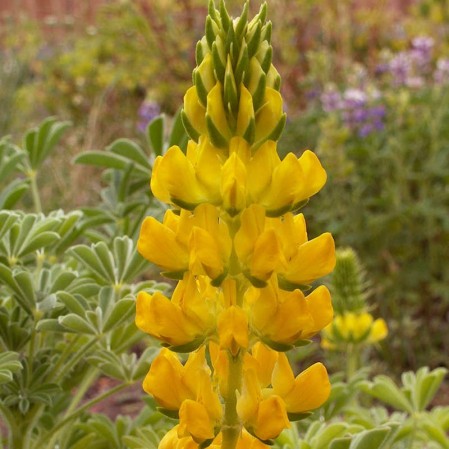Yellow Lupine Seeds
- HOW TO GROW
- FAST FACTS
- REVIEWS
HOW TO GROW
Sowing: To soften the hard coating on these seeds, rub them lightly with sandpaper or soak them in 180 degrees F water overnight before sowing. Sow them in early spring, planting 1/2" deep. Keep the soil lightly moist until germination.
Growing: These seedlings grow very slowly and are rather fragile. Water them occasionally and protect from freezing temperatures. Though mature plants tolerate drought conditions well, provide water occasionally in very dry weather. This plant can be poisonous to livestock if present in excessive amounts. These plants resent having their roots disturbed.
Harvesting: For cut flowers, choose stems with flowers that have just opened. Strip the foliage that will fall below the water level, and place in water immediately.
Seed Saving: As the seed pods develop, watch them carefully. As soon as they ripen fully they will split and drop their seed. When the pods begin to turn brown, remove them and spread them out to dry. Remove the seed from the pods and store it in a cool, dry place. Keep in mind that these seeds are highly poisonous.
FAST FACTS
Common Names: Whitewhorl Lupine, Dense-Flowered Lupine
Latin Name: Lupinus densiflorus
Species Origin: US Native Wildflower
Type: Native Wildflowers
Life Cycle: Annual
USDA Zones: 2, 3, 4, 5, 6, 7, 8, 9, 10, 11, 12
US Regions: California, Mountain, Arid/Desert, Plains/Texas, Midwest, Northern, Northeast, Southeast
Seeds per Ounce: 700
Stratification: No Stratification
Germination Ease: No Stratification
Sunlight: Full Sun
Height: 30 Inches
Color: Yellow
Bloom Season: Blooms Late Spring, Blooms Early Summer
Uses: Deer Resistant
Yellow Lupines
Everwilde sent these seeds very promptly. I soaked them, as the seed pack suggested and decided to nick the seed coats for added insurance. They're germinating very well!
Unusual Lupine Color
Thank you, Everwilde, for your vast selection of most wonderful Seeds.
DESCRIPTION

HOW TO GROW
Sowing: To soften the hard coating on these seeds, rub them lightly with sandpaper or soak them in 180 degrees F water overnight before sowing. Sow them in early spring, planting 1/2" deep. Keep the soil lightly moist until germination.
Growing: These seedlings grow very slowly and are rather fragile. Water them occasionally and protect from freezing temperatures. Though mature plants tolerate drought conditions well, provide water occasionally in very dry weather. This plant can be poisonous to livestock if present in excessive amounts. These plants resent having their roots disturbed.
Harvesting: For cut flowers, choose stems with flowers that have just opened. Strip the foliage that will fall below the water level, and place in water immediately.
Seed Saving: As the seed pods develop, watch them carefully. As soon as they ripen fully they will split and drop their seed. When the pods begin to turn brown, remove them and spread them out to dry. Remove the seed from the pods and store it in a cool, dry place. Keep in mind that these seeds are highly poisonous.
FAST FACTS
Common Names: Whitewhorl Lupine, Dense-Flowered Lupine
Latin Name: Lupinus densiflorus
Species Origin: US Native Wildflower
Type: Native Wildflowers
Life Cycle: Annual
USDA Zones: 2, 3, 4, 5, 6, 7, 8, 9, 10, 11, 12
US Regions: California, Mountain, Arid/Desert, Plains/Texas, Midwest, Northern, Northeast, Southeast
Seeds per Ounce: 700
Stratification: No Stratification
Germination Ease: No Stratification
Sunlight: Full Sun
Height: 30 Inches
Color: Yellow
Bloom Season: Blooms Late Spring, Blooms Early Summer
Uses: Deer Resistant
Reviews
Review
Yellow Lupines
Everwilde sent these seeds very promptly. I soaked them, as the seed pack suggested and decided to nick the seed coats for added insurance. They're germinating very well!
Review
Unusual Lupine Color
Thank you, Everwilde, for your vast selection of most wonderful Seeds.






